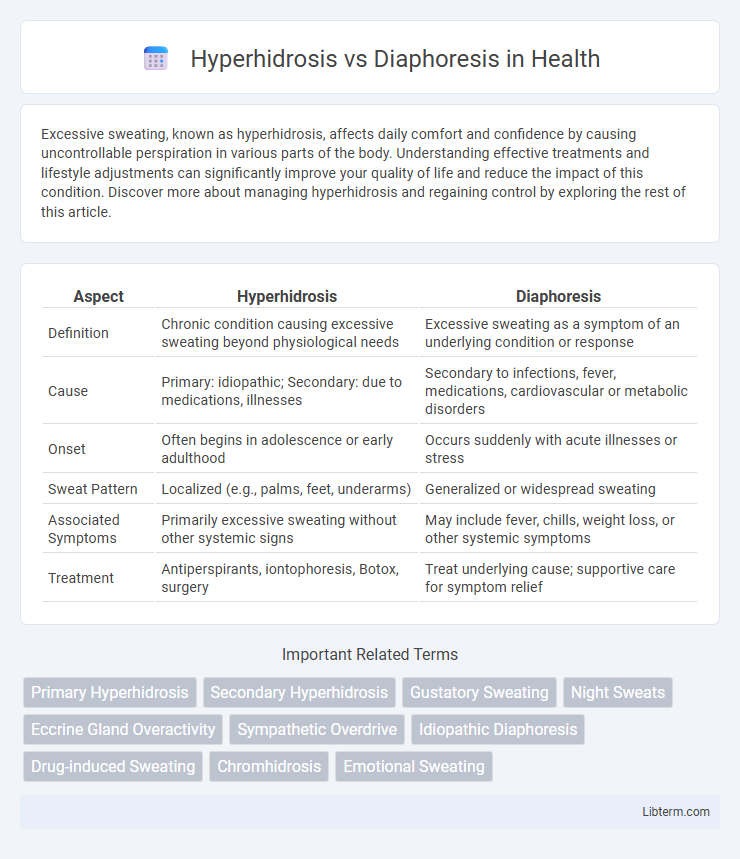Excessive sweating, known as hyperhidrosis, affects daily comfort and confidence by causing uncontrollable perspiration in various parts of the body. Understanding effective treatments and lifestyle adjustments can significantly improve your quality of life and reduce the impact of this condition. Discover more about managing hyperhidrosis and regaining control by exploring the rest of this article.
Table of Comparison
| Aspect | Hyperhidrosis | Diaphoresis |
|---|---|---|
| Definition | Chronic condition causing excessive sweating beyond physiological needs | Excessive sweating as a symptom of an underlying condition or response |
| Cause | Primary: idiopathic; Secondary: due to medications, illnesses | Secondary to infections, fever, medications, cardiovascular or metabolic disorders |
| Onset | Often begins in adolescence or early adulthood | Occurs suddenly with acute illnesses or stress |
| Sweat Pattern | Localized (e.g., palms, feet, underarms) | Generalized or widespread sweating |
| Associated Symptoms | Primarily excessive sweating without other systemic signs | May include fever, chills, weight loss, or other systemic symptoms |
| Treatment | Antiperspirants, iontophoresis, Botox, surgery | Treat underlying cause; supportive care for symptom relief |
Understanding Hyperhidrosis: Definition and Causes
Hyperhidrosis is a medical condition characterized by excessive, uncontrollable sweating beyond what is necessary for thermoregulation, often localized to areas such as hands, feet, underarms, and face. It can be primary, stemming from overactive sweat glands without an underlying cause, or secondary, resulting from medical conditions like hyperthyroidism, diabetes, or certain medications. Differentiating hyperhidrosis from diaphoresis, which is generalized sweating often linked to systemic illness or stress, is essential for accurate diagnosis and targeted treatment.
What is Diaphoresis? Key Features and Triggers
Diaphoresis is excessive sweating that occurs as a physiological response to various triggers such as heat, fever, intense physical activity, or underlying medical conditions like infections and cardiovascular disorders. Key features include profuse, often uncontrollable sweating that may affect the entire body or localized areas. Unlike hyperhidrosis, which is a chronic condition characterized by abnormal sweating without obvious triggers, diaphoresis typically signals an acute response to external or internal stimuli.
Hyperhidrosis vs Diaphoresis: Core Differences
Hyperhidrosis is a chronic condition characterized by excessive sweating beyond what is necessary for thermoregulation, often localized to specific areas such as the palms, soles, or underarms. Diaphoresis refers to excessive sweating that typically occurs as a symptom of an underlying medical condition, stress, or medication effect, and it usually affects the entire body. The core difference lies in hyperhidrosis being a primary disorder with unknown causes, while diaphoresis is secondary and linked to systemic issues or external triggers.
Symptoms Comparison: Hyperhidrosis and Diaphoresis
Hyperhidrosis is characterized by excessive, uncontrollable sweating that usually occurs in specific areas such as the palms, soles, and underarms without an obvious trigger. Diaphoresis involves generalized sweating often linked to underlying medical conditions like infections, heart problems, or anxiety. Hyperhidrosis symptoms are chronic and often idiopathic, while diaphoresis is typically acute and secondary to other health issues.
Underlying Medical Conditions Linked to Each
Hyperhidrosis is often linked to primary causes such as genetic factors or autonomic nervous system dysfunction, whereas diaphoresis typically indicates an underlying medical condition like infections, cardiovascular issues, or endocrine disorders. Hyperhidrosis is generally localized and chronic, while diaphoresis presents as generalized excessive sweating associated with acute or systemic illnesses. Identifying these distinctions helps tailor diagnostic and treatment strategies for conditions like diabetes, tuberculosis, or heart failure, which are commonly related to diaphoresis.
Diagnostic Approaches: How Doctors Distinguish the Two
Diagnostic approaches for distinguishing hyperhidrosis from diaphoresis involve a thorough patient history and physical examination focusing on sweating patterns and triggers. Hyperhidrosis is characterized by excessive, localized sweating often without an underlying condition, while diaphoresis typically indicates generalized sweating linked to systemic issues like infections or cardiac events. Specialized tests such as the iodine-starch test for hyperhidrosis and laboratory evaluations for diaphoresis-related diseases aid clinicians in accurate diagnosis.
Treatment Options: Managing Hyperhidrosis and Diaphoresis
Treatment options for hyperhidrosis include topical antiperspirants containing aluminum chloride, oral anticholinergic medications, botulinum toxin injections, and in severe cases, sympathectomy surgery. Diaphoresis management targets underlying causes such as infections, medications, or systemic diseases, often involving antipyretics, antibiotics, or treating hormonal imbalances. Both conditions require individualized approaches based on severity and underlying factors to effectively control excessive sweating.
Lifestyle Adjustments for Symptom Relief
Managing hyperhidrosis and diaphoresis through lifestyle adjustments includes wearing breathable, moisture-wicking fabrics to reduce discomfort and skin irritation. Maintaining a cool environment and using antiperspirants with aluminum chloride can significantly decrease excessive sweating episodes. Stress reduction techniques, such as meditation and regular exercise, help regulate sweat gland activity and improve overall quality of life.
When to See a Doctor: Warning Signs and Red Flags
Seek medical attention for hyperhidrosis if excessive sweating disrupts daily activities or leads to skin infections and emotional distress. Diaphoresis accompanied by chest pain, shortness of breath, sudden weakness, or confusion may indicate serious conditions like heart attack or infection requiring urgent evaluation. Persistent or unexplained sweating with weight loss or fever also warrants prompt medical assessment to rule out underlying diseases.
Frequently Asked Questions: Hyperhidrosis vs Diaphoresis
Hyperhidrosis is a chronic condition characterized by excessive and uncontrollable sweating, often localized to areas such as the hands, feet, underarms, and face, while diaphoresis refers to generalized, excessive sweating typically caused by underlying medical conditions like infections, heart problems, or anxiety. Frequently asked questions often involve distinguishing whether sweating is a primary disorder (hyperhidrosis) or a symptom of another issue (diaphoresis), how to manage symptoms, and when to seek medical evaluation. Effective treatment for hyperhidrosis includes antiperspirants, prescription medications, or procedures like Botox, whereas diaphoresis treatment focuses on addressing the root cause of the excessive sweating.
Hyperhidrosis Infographic

 libterm.com
libterm.com